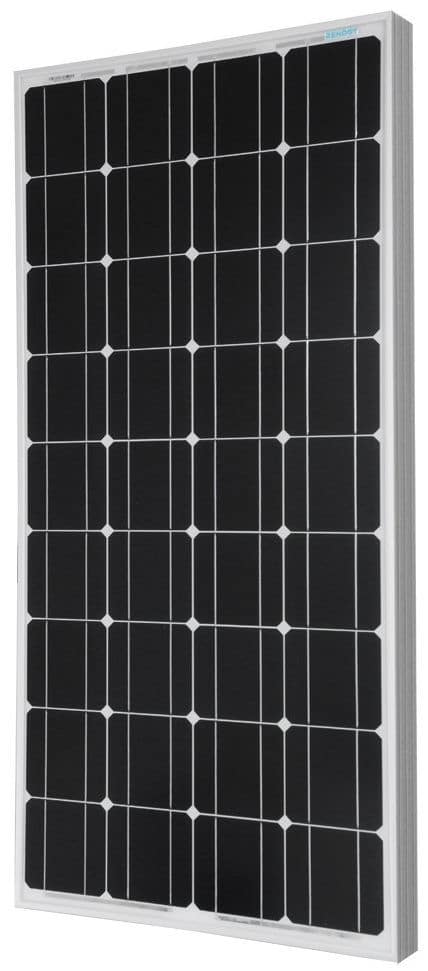
Connecting Solar Panels Together
How to Connect Solar Panels Together
![]() Connecting solar panels together is a simple and effective way of increasing your solar power capabilities. Going green is a great idea, and as the sun is our ultimate power source, it makes sense to utilize this energy to power our homes. As solar power becomes more accessible, more and more homeowners are buying photovoltaic solar panels.
Connecting solar panels together is a simple and effective way of increasing your solar power capabilities. Going green is a great idea, and as the sun is our ultimate power source, it makes sense to utilize this energy to power our homes. As solar power becomes more accessible, more and more homeowners are buying photovoltaic solar panels.
However, these photovoltaic solar panels can be very costly so buying them over time helps to spread the cost. But the problem then becomes how do we connect these extra solar panels together to increase the voltage and power output of what’s already there.
The trick here when connecting solar panels together is to choose a connection method that is going to give you the most energy efficient configuration for your particular requirements.
Connecting solar panels together can seem like a daunting task when you first start to look at how it should be done, but connecting multiple solar panels together is not that hard with a little thought. Wiring solar panels together in either parallel or series combinations to make larger arrays is an often overlooked, yet completely essential part of any well designed solar power system.
There are three basic but very different ways of connecting solar panels together and each connection method is designed for a specific purpose. For example, to produce more output voltage or to produce more current.
Solar photovoltaic panels can be electrically connected together in series to increase the voltage output, or they can be connected together in parallel to increase the output amperage. Solar pv panels can also be wired together in both series and parallel combinations to increase both the output voltage and current to produce a higher wattage array.
Whether you are connecting two or more solar panels, as long as you understand the basic principles of how connecting multiple solar panels together increases power and how each of these wiring methods works, you can easily decide on how to wire your own panels together. After all connecting solar panels together correctly can greatly improve the efficiency of your solar system.
Connecting Solar Panels Together in Series
The first method we will look at for connecting solar panels together is what’s known as “Series Wiring“. The electrical connection of solar panels in series increases the total system output voltage. Series connected solar panels are generally used when you have a grid connected inverter or charge controller that requires 24 volts or more. To series wire the panels together you connect the positive terminal to the negative terminal of each panel until you are left with a single positive and negative connection.
Solar panels in series add up or sum the voltages produced by each individual panel, giving the total output voltage of the array as shown.
Solar Panels in Series of Same Characteristics
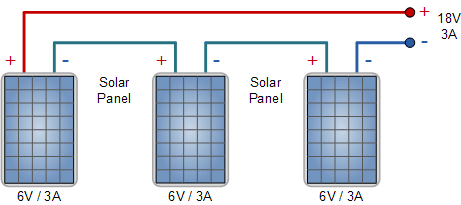
In this method ALL the solar panels are of the same type and power rating. The total voltage output becomes the sum of the voltage output of each panel. Using the same three 6 volt, 3.0 amp panels from above, we can see that when these pv panels are connected together in series, the array will produce an output voltage of 18 Volts (6 + 6 + 6) at 3.0 Amperes, giving 54 Watts (volts x amps) at full sun.
Now lets look at connecting solar panels in series with different nominal voltages but with identical current ratings.
Solar Panels in Series of Different Voltages
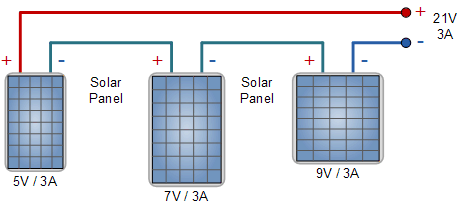
In this method all the solar panels are of different types and power rating but have a common current rating. When they are connected together in series, the array produces 21 volts at 3.0 amps, or 63 watts. Again the output amperage will remain the same as before at 3.0 amps but the voltage output jumps to 21 volts (5 + 7 + 9) .
Finally, lets look at connecting solar panels in series with completely different nominal voltages and different current ratings.
Solar Panels in Series of Different Currents
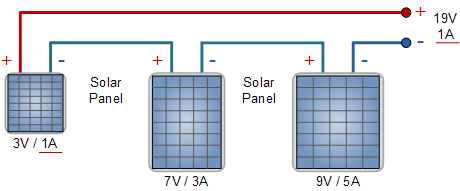
In this method all the solar panels are of different types and power rating. The individual panel voltages will add together as before, but this time the amperage will be limited to the value of the lowest panel in the series string, in this case 1 Ampere. Then the array will produce 19 Volts (3 + 7 + 9) at 1.0 Ampere only, or only 19 watts out of a possible 69 watts available reducing the arrays efficiency.
We can see that the solar panel rated at 9 volts, 5 amps, will only use one fifth or 20% of its maximum current potential reducing its efficiency and wasting money on the purchase of this solar panel. Connecting solar panels in series with different current ratings should only be used provisionally, as the solar panel with the lowest rated current determines the current output of the whole array.
Connecting Solar Panels Together in Parallel
The next method we will look at of connecting solar panels together is what’s known as “Parallel Wiring“. Connecting solar panels together in parallel is used to boost the total system current and is the reverse of the series connection. For parallel connected solar panels you connect all the positive terminals together (positive to positive) and all of the negative terminals together (negative to negative) until you are left with a single positive and negative connection to attach to your regulator and batteries.
When you connect solar panels together in parallel, the total voltage output remains the same as it would for a single panel, but the output current becomes the sum of the output of each panel as shown.
Solar Panels in Parallel of Same Characteristics
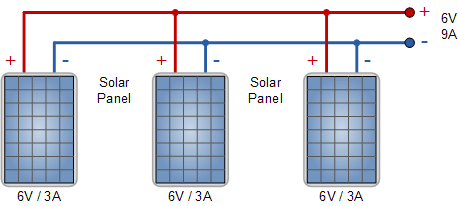
In this method ALL the solar panels are of the same type and power rating. Using the same three 6 Volt, 3.0 Amp panels as above, the total output of the panels, when connected together in parallel, the output voltage still remains at the same value of 6 volts, but the total amperage has now increased to 9.0 Amperes (3 + 3 + 3), producing 54 watts at full sun.
But what if our newly acquired solar panels are non-identical, how will this affect the other panels. We have seen that the currents add together, so no real problem there, just as long as the panel voltages are the same and the output voltage remains constant. Lets look at connecting solar panels in parallel with different nominal voltages and different current ratings.
Solar Panels in Parallel with Different Voltages and Currents
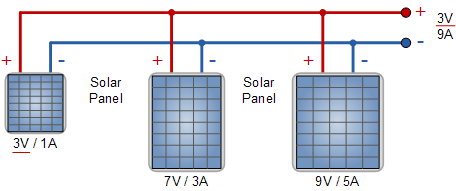
Here the parallel currents add up as before but the voltage adjusts to the lowest value, in this case 3 volts or some voltage value very close to 3 volts. Solar panels must have the same output voltage to be useful in parallel. If one panel has a higher voltage it will supply the load current to the degree that its output voltage drops to that of the lower voltage panel.
We can see that the solar panel rated at 9 volts, 5 amps, will only operate at a maximum voltage of 3 volts as its operation is being influenced by the smaller panel, reducing its efficiency and wasting money on the purchase of this higher power solar panel. Connecting solar panels in parallel with different voltage ratings is not recommended as the solar panel with the lowest rated voltage determines the voltage output of the whole array.
Then when connecting solar panels together in parallel it is important that they ALL have the same nominal voltage value, but it is not necessary that they have the same ampere value.
Connecting Solar Panels Together Summary
Connecting solar panels together to form bigger arrays is not all that complicated. How many series or parallel strings of panels you make up per array depends on what amount of voltage and current you are aiming for. If you are designing a 12 volt battery charging system than parallel wiring is perfect. If you are looking at a higher voltage grid connected system, than you’re probably going to want to go with a series or series-parallel combination depending on the number of solar panels you have.
But for a simple reference in regards to how to connect solar panels together in either parallel or series wiring configurations, just remember that parallel wiring = more amperes, and series wiring = more voltage, and with the right type and combination of solar panels you can power just about any electrical device you may have in your home.
For more information about Connecting Solar Panels Together in either series or parallel combinations, or to obtain more information about the different types of solar panels available, or to explore the advantages and disadvantages of using solar power in your home, then Click Here to order your copy from Amazon today and learn more about designing, wiring and installing off-grid photovoltaic solar electric systems in your home.





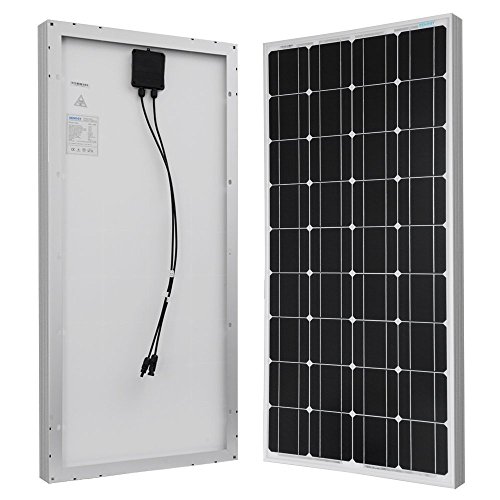





Hi Dear
we have 40 PV panel each 100 W .17.5 volt and 5.5 Amp .with inverter type PV 1800 .rated power 3000Va/300W.MD PV18-3024 VPM.
what is the best way to connecter off grid with storage batteries 4x 175 Amp each .
to get at least 5 amp at neighs for 8 hours
best Regards
Moussa sader .
South Lebanon
Hello, I am looking for an off grid system, the Growatt/Bluesun 5000ES Hybrid inverter, seems very popular.
Looks like pricewise & size limits me to 560w panels so 50v & 13A ish.
If inverter is 450v max and 22A max can I use 10 panels, perhaps 8 in series and last 2 in parallel, is this ok.
Tony
Hello, we cannot recommend one particular inverter over another but the Growatt SPF 5000ES is a very good off-grid inverter. The maximum power point DC input range is between 150V and 430VDC with a Voc of 450V and a maximum Isc of 100 Amperes, so any single string configuration of your PV array should not exceed these values.
I have lived off grid 14 years and accumulated 3 strings of panels all wired in series ,1 as 3 x 300w , 1 as 6 x180w and 1 as 4x 220w. at peak sun on july 15 I only get 1740 watts total power. I want to add a string of 5 panels in parallel of 330 watts, these have diodes. and I havent had success in connecting them can they be in a string of 5or do I need 6 panels and run them through my combiner box with the series wired panels. please help ,thanks.
The configuration of additional panels into our array will depend greatly on the input I-V characteristics of your controller/inverter. The use of different wattage photovoltaic panels within your array will result in mismatch losses because different panels in the array have different parameters. Thus the mismatch in current-voltage (I-V) characteristics of different panels will cause significant power loss in the array. As a result, the actual output power from your array will be less than the summation of the power outputs corresponding to the individual PV panels, 2860 watts in your example. Impedance mismatch between array and load (batteries or inverter) will also reduce expected power output.
Sir I have a 7.5 kV mppt inverter with PV voltage 320voc and mppt voltage range is 175-266v And have 14 solar panels of 49.139 voc so how to connect them to have batter result for my inverter charging should I connect them in 6 in series 3 in parrels
Without knowing your panel details, a Voc of 49.139 volts would produce about 42 Vmp volts (about 400W). If your inverter has an mppt range of 175-266 volts, then the maximum series string would be six (6) panels (266/42). Thus you would connect the panels as 6 in series and 2 parallel branches (6S2P). If you purchased an addition identical panel (15 in total), you could go 5S3P.
Hi, I have 63 panel of 335 Wp and UOC = 41,5 . The invertor says it have maximum input voltage 1000V and have 2 MMPT .
How i conect these panel? THANKS.
1000V divided by Voc = 41,5V = 24 series panels maximum.
As you have 63 panels, then 3 parallel branches of 21 panels (21S3P), or combinations thereof
Hi, thanks alot for the explanation.its simple and well explained.
Looking for more about the protection and solar chargers control that are required for effective charging. Thanks.
Hello, i have already installed 10 solar panels ( Longi 550w ) with Voc=49.80 and Isc=13.98
Can i connect 5 panels in series and the remaining 5 in series and put them in parallel to each other (series – parallel) configuration, so that the Voc will bel 249v and the Isc will 27.96a due to parallel connection.
If having a Growatt 5kw inverter (spf 5000es) with max pv array power of 6000w, max Voc= 450v, pv array MPPT voltage range 120~430Vdc, and max pv input current= 22a.
The point is it safe to input 27.96a from pv panels on 22a inverter?
If your inverter is rated at a maximum array input of 22 amperes. Then it would not be advisable to subject it to nearly 28 amperes. Internally it may become damaged.
I need to learn solar system
Hi so I purchased an rv that has a go power 190w panel (20.4vmp and 9.45imp) I also have a pre purchased renogy 200watt kit that has 2x 100w panels (20.4Vmp and 4.91imp each)So if I read this correct, I can connect these in a parallel set up and I should get 19.27imp at 20.4vmp. For a total of 393watts for the system under optimal sun.
When PV panels are connected in parallel, the individual currents “add”, but the voltage is the “average” of the panels. For example, Vparallel = (VP1 + VP2 + VP3 …… + VPn)/Vn and Iparallel = IP1 + IP2 + IP3 ……. + IPn, etc. Thus for dissimilar PV panels the output voltage will always be towards the lower panels value.
As stated that your three 12 volt PV panels are all rated at 20.4V, Then Vparallel = (20.4 + 20.4 + 20.4)/3 = 20.4 volts and Iparallel to equal 9.45 + 4.91 + 4.91 = 19.27 amperes at full sun.
Hey I have 3 12v batteries 1.5kva inverter how many 300watts solar panels do I need to the batteries at full sun
Depends on the size and type of Deep Cycle battery you have as well as load size and duration in hours that you want your load to be powered
Hi my friend , i have 5.5kw inverter 48 volts , also 10 panels 545 watt each , i have joined them parallel (+) (-) all and took last 2 opposite sides negative and positive … i gained almost 430 volts but in my app shows in WATT too low like 670 watt i have from frm panels . What do you recomend me to do
Nothing. Monitor your app over a period of several months to see how your system performs, morning, solar noon and night throughout the year, and then decide if changes are required. One 670 watt reading tells you nothing.
Hi i have 12 solar panels 330 watts for a house and a 4g solis inverter what is the best way to connect solar panels together?
Clearly that would depend on the maximum DC input parameters of your inverter
Hi i dont know much about solar just checked max dc input 3.5kw 600v can i do 6 in series and 6 in parrallel?
its a solis mini 3000 4g
Look, if you make the effort to read the manual for the inverter it states: “Max. Input Voltage = 600VDC” and “Max. Input Current = 11A”. Then the configuration of your 12 panels must not exceed 600 Volts or 11 Amperes. 330 watt panels should be 24V panels x 75% would give an Open-circuit voltage, VOC of approximately 24 x 1.75 = 42 volts. If VOC = 42 volts (check datasheet) per panel then: 600/42 = 14 series panels maximum per string. You state you have 12 panels, then 12 x 42 = 500 volts, within the 600V limit. ISC for a 330W panel is less than 10 Amperes (check datasheet), then a single series string is required.
I have a 50 watt renogy solar setup in my shed wanting to add another 50 watt panel to it do I need connectors?
Well of course. How else will you electrically connect the two panels together
I have two solar panel at 275watts and two 220ah battery.how many amp solar controller do I need to use
I have two 275wtts solar panel what is the best solar controller ,inverter and battery size if I want to use a deep freezer
Clearly the daily consumption, and therefore battery storage required will depend on your deep freezer and whether two panels are sufficient to power it. The choice of inverter depends on your solar panel and battery bank configuration. The battery(s) required is commonly based on your daily power usage and the battery type.
You have: 2 x 275W = 550 watts of solar power at FULL sun maximum. If you get FULL sun for an average of 5 hours per day, then: 550W x 5h = 2750Wh, or 2.75kWh. For 50% depth of charge and 80% efficiency, 2.75kWh x 2 x 1.2 = 6.6kWh. Thus, 6.6kWh at 12 volts is equal to: 6600/12 = 550 amp hours of battery capacity minimum, or 275Ah at 24V. Then you can build your system around that, the choice is yours.
If I connect 4×335 watt panel’s in series, parallel what wattage can I expect to see?
4 x 335W = 1340 watts (or 1.34kW) at FULL sun
Lets say I have a on grid system that drops out when the power is off and I want to shut that system off and energies it with an off grid system but I’ll need a gate to stop back feed to the off grid system ( Diode ) as the gate. I am looking for a little direction & for parts supply. My on grid will match sign wave coming in from Edison and so would it do the same with off grid ? and would you suggest some kind of capacitor arrangement to curb any spike or as a pad ?
Hello, your question/comment makes no sense. Lets say you write it in proper English.
I need a device that only lets a/c power flow one way in 30 amp per 110 volt leg . and a supplier for the parts ?
Then you need a 30 ampere rated Rectifier
Good day,
I have two pieces of 12V 100Ah VRLA batteries, two pieces of 24V 380W mono solar panels, one piece of 60A 12V/24V/48V MPPT charge controller and one 2KVA 24Vdc Inverter. What is the best method of connecting the solar panels to obtain maximum efficiency; series or parallel connection?
You have two 380 watt panels which will produce a total of 760 watts (2 x 380) at “Full Sun” no matter how they are connected. “to obtain maximum efficiency” point them at the sun and keep them cool as they directly influence the energy production and efficiency
Dear sir/Md, thank you so much for the teaching, I love it.
Pls I have a 200ah/12V battery,
2 200 watts panel, 850va/12v inverter. Please how do I connect series or parallel?
You have two 12V panels and one 12V battery. Then two panels in parallel at 12 volts.
Thank you for the prompt response, the solar panels are 24v each, pwm or mppt controller which would you recommend I use ?
If the solar panels are 24v each . Connect them in parallel. Register the battery’s nominal voltage on the pwm co troller before connecting the solar panel to it.
Good evening. I have 5kva 48volts Inverter and 8 pieces of 220ah batteries. How many of 300 watts panel do i need to get the batteries fully charged at Peak Sun
I have a 1.5kva inverter and 2(220ah) batteries. How many of 180w panels does i need to get full charge at Peak of the Sun.
6panels of 180 should be more than enough
Thanks and Oh I forgot to specify the rating on my charger controller
12v/24v
Max PV 50v
Maxx PV input Power: 390w(12v) 780w(24v)
Will this be okay for the 6panel recommended for a full charger at peak of the sun?